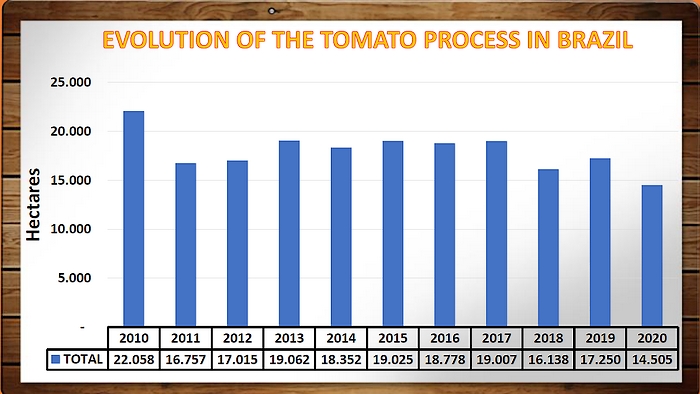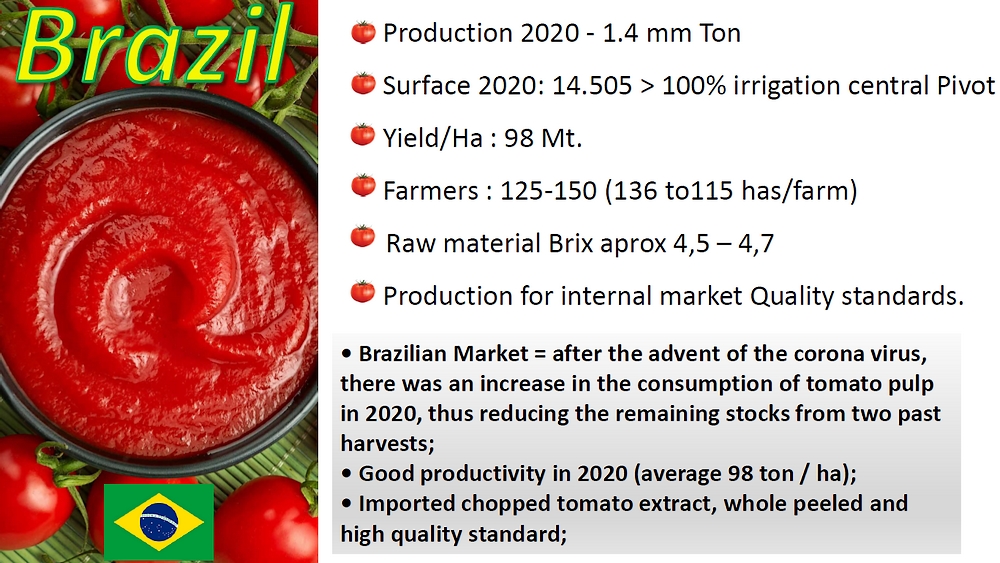Press release
, François-Xavier Branthôme
Congresso Brasileiro de Tomate Industrial OnLine
From the presentation by Leandro André Feller during the Congresso Brasileiro de Tomate Industrial Online, held from 24 to 26 November 2020.
 Owing to the epidemiological situation in the country, the 10th edition of the Brazilian Processing Tomato Congress was held online from 24 to 26 November 2020.
The Congress, which has been taking place since 2007, has found its identity as an important and traditional event for the industry in Brazil. All previous editions were held in Goiás, which is the main region of cultivation for processing tomatoes in Brazil and has the largest park of manufacturing plants for tomato products in the country.
Owing to the epidemiological situation in the country, the 10th edition of the Brazilian Processing Tomato Congress was held online from 24 to 26 November 2020.
The Congress, which has been taking place since 2007, has found its identity as an important and traditional event for the industry in Brazil. All previous editions were held in Goiás, which is the main region of cultivation for processing tomatoes in Brazil and has the largest park of manufacturing plants for tomato products in the country.
The event brings together growers, suppliers, professionals from the public and private sectors, researchers, teachers, students, national and international speakers – all of whom seek not only to improve the industry, but also want to exchange knowledge, experience and information, in addition to finding new business opportunities.
Among other well-known experts (see the program and speakers’ list below), Leandro Feller (Technical Commercial Coordination at Eagle Flores Frutas e Hortaliças, working in the States of Goiás, Minas Gerais and São Paulo) highlighted some important points regarding the Brazilian production of processing tomatoes during the 2020 harvest.

This illustration provides a glimpse of the evolution of Brazil’s planted surfaces for processing tomatoes. It is worth noting that the planted area reached its highest level in 2010 with 22,058 hectares. Planted surfaces started decreasing in 2011, varying around 19,000 to as low as 14,505 hectares in 2020. Last season, the Brazilian tomato acreage reached its lowest level of the past ten years.

Over the years, the State of Goiás has stood out as the state with the largest planted area. As of 2012, the planted area in the State of São Paulo has varied from 3,468 to 3,004 hectares, which indicates a remarkably stable surface area. The State of Minas Gerais has an average planted area of 2,200 hectares.
As the state of Goiás covers the largest planted area in Brazil, it presents a greater variation – from 16,296 to the 9,423 hectares planted during the current 2020 harvest.
Since the year 2017, planting tomatoes for processing has not been particularly attractive in the north-eastern region, and manufacturers in that area have chosen to buy tomato pulp from processing operators in the southeast and central-western regions.

When expressed as a percentage of total planted area, it is clear that 65% of the country’s planted surfaces are found in the state of Goiás, with 9,423 hectares. 14% of Brazilian surfaces dedicated to processing tomatoes are located in Minas Gerais with 2,027 hectares. The state of São Paulo represents 21% of the planted area with 3,055 hectares.

Summary of our field survey, based on the information provided by tomato processing operators:
• 2020 production: 1.4 million metric tonnes of raw material
• 2020 planted surfaces: 14.505 > 100% aspersion irrigation by central pivot
• Yield/ha: 98 metric tonnes.
• Growers: 125-150 (115 to 136 ha per farm)
• Raw material Brix° approx. 4.5 to 4.7
Conclusions:
• The Brazilian market as a whole: since the advent of the coronavirus, there has been an increase in the consumption of tomato pulp in 2020, thus reducing the stocks remaining from the past two harvests.
• A good productivity has been recorded in 2020 (average 98 metric tonnes/ha).
• Imports include pulped tomato and whole-peeled canned tomatoes of a high quality standard.
• Due to the low stocks of tomato pulp resulting from higher consumption in 2020, a tendency to increase planted surfaces has been observed in 2021.
 Some complementary data:
Some complementary data:
https://app.virtualieventos.com.br/cbtionline/info
https://app.virtualieventos.com.br/cbtionline/programacao
https://app.virtualieventos.com.br/cbtionline/palestrantes
Further details in the attached document:



































